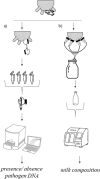Presence of pathogen DNA in milk harvested from quarters is associated to changes in cows' milk yield and composition
- PMID: 38849801
- PMCID: PMC11157801
- DOI: 10.1186/s12917-024-04083-y
Presence of pathogen DNA in milk harvested from quarters is associated to changes in cows' milk yield and composition
Abstract
Background: Intramammary infection is the result of invasion and multiplication of microorganisms in the mammary gland and commonly leads to mastitis in dairy animals. Although much has been done to improve cows' udder health, mastitis remains a significant and costly health issue for dairy farmers, especially if subclinical. In this study, quarter milk samples from clinically healthy cows were harvested to detect pathogens via quantitative PCR (qPCR) and evaluate changes in individual milk traits according to the number of quarters infected and the type of microorganism(s). A commercial qPCR kit was used for detection of Mycoplasma bovis, Mycoplasma spp., Staphylococcus aureus, coagulase-negative staphylococci (CNS), Streptococcus agalactiae, Streptococcus dysgalactiae, Streptococcus uberis, Prototheca spp., Escherichia coli, Klebsiella spp., Enterococcus spp. and Lactococcus lactis ssp. lactis. Quarter and pooled milk information of 383 Holstein, 132 Simmental, 129 Rendena, and 112 Jersey cows in 9 Italian single-breed herds was available.
Results: Among the cows with pathogen(s) present in at least 1 quarter, CNS was the most commonly detected DNA, followed by Streptococcus uberis, Mycoplasma bovis, and Streptococcus agalactiae. Cows negative to qPCR were 206 and had the lowest milk somatic cell count. Viceversa, cows with DNA isolated in ≥ 3 quarters were those with the highest somatic cell count. Moreover, when major pathogens were isolated in ≥ 3 quarters, milk had the lowest casein index and lactose content. In animals with pathogen(s) DNA isolated, the extent with whom milk yield and major solids were impaired did not significantly differ between major and minor pathogens.
Conclusions: The effect of the number of affected quarters on the pool milk quality traits was investigated in clinically healthy cows using a commercial kit. Results remark the important negative effect of subclinical udder inflammations on milk yield and quality, but more efforts should be made to investigate the presence of untargeted microorganisms, as they may be potentially dangerous for cows. For a smarter use of antimicrobials, analysis of milk via qPCR is advisable - especially in cows at dry off - to identify quarters at high risk of inflammation and thus apply a targeted/tailored treatment.
Keywords: Intramammary infection; Sterile milk sampling; Udder health; qPCR.
© 2024. The Author(s).
Conflict of interest statement
The authors declare no competing interests.
Figures




Similar articles
-
Pathogen Detection via Quantitative PCR in Milk of Healthy Cows Collected Using Different Sampling Protocols.Pathogens. 2023 Jul 13;12(7):935. doi: 10.3390/pathogens12070935. Pathogens. 2023. PMID: 37513782 Free PMC article.
-
Factors associated with intramammary infection in dairy cows caused by coagulase-negative staphylococci, Staphylococcus aureus, Streptococcus uberis, Streptococcus dysgalactiae, Corynebacterium bovis, or Escherichia coli.J Dairy Sci. 2017 Jan;100(1):493-503. doi: 10.3168/jds.2016-11465. Epub 2016 Oct 27. J Dairy Sci. 2017. PMID: 28341052
-
Postcalving udder health and productivity in cows approaching dry-off with intramammary infections caused by non-aureus Staphylococcus, Aerococcus, Enterococcus, Lactococcus, and Streptococcus species.J Dairy Sci. 2021 May;104(5):6061-6079. doi: 10.3168/jds.2020-19288. Epub 2021 Mar 6. J Dairy Sci. 2021. PMID: 33685704
-
Elimination of selected mastitis pathogens during the dry period.J Dairy Sci. 2018 Oct;101(10):9332-9338. doi: 10.3168/jds.2018-14759. Epub 2018 Jul 25. J Dairy Sci. 2018. PMID: 30055920
-
Udder infections with Staphylococcus aureus, Streptococcus dysgalactiae, and Streptococcus uberis at calving in dairy herds with suboptimal udder health.J Dairy Sci. 2016 Mar;99(3):2102-2117. doi: 10.3168/jds.2015-9487. Epub 2016 Jan 21. J Dairy Sci. 2016. PMID: 26805990
References
-
- International Dairy Federation (FIL/IDF). Bulletin of the IDF N° 515/2022: Guidelines for defining quarter and udder health status and cured clinical and subclinical mastitis cases. 2022. 10.56169/EDNH6007.
MeSH terms
Substances
Supplementary concepts
Grants and funding
LinkOut - more resources
Full Text Sources
Miscellaneous

